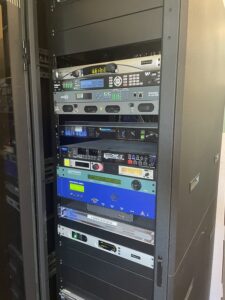PROVINCETOWN — Atop Mount Gilboa, perhaps more dune than mountain, sits a large light blue water tower whose paint has begun to fade and flake. A radio antenna sticks out from its roof and a thick black cable snakes down toward a small shed in the structure’s shadow.

The shack, home to WOMR’s radio transmitter, is objectively unsexy, according to the station’s part-time broadcast engineer, Chris Kelly. It’s the type of place where extended stays are probably an indication that something has gone awry, like now.
WOMR’s transmitter has been coming up short. The device is broadcasting at around 2,600 watts, well short of the station’s licensed 6,000. Less power means less range. Several factors have contributed to the decline, notably its age, but one incident provided the largest shock — pun intended.
After a meeting in Truro last summer, WOMR Executive Director John Braden heard dead air on the radio and headed straight to Mount Gilboa. Inside the shack, he “smelled a burning.” Braden, with Kelly’s help, later discovered that a bug had snuck into the transmitter, possibly attracted by the heat it gives off, and electrocuted itself.
The result was frazzled circuitry throughout the device.
The transmitter has not been able to recover from the encounter, although Kelly, who works full-time for WGBH in Boston, noted that the larger long-term factor is the damaging “caustic air” from the ocean. Kelly and the machine’s manufacturer later decided a replacement was necessary. It will cost $135,000.
The Radio Process
The Mount Gilboa transmitter, which lives a little over a mile from the WOMR studio on a service road off Route 6A, is one of the last stops on the sonic journey from the station to your car’s radio.

The path begins in the studio, where the station’s volunteer DJs have a variety of options when it comes to producing sound. From microphones to record players, all are routed through the mixing board.
Between three and four dozen wires connect the studios to the building’s attic, said Braden. That “spaghetti” eventually reaches a small transmitter on-site from which the signal is ferried along more wires into a dish in the station’s bell tower. It then beams the broadcast using microwaves to a receiver located on top of the unsexy shack.
That initiates a similar transfer process on Mount Gilboa, where the signal travels through a second larger radio transmitter — which amplifies the audio signal to 6,400 watts — and directs it through “super heavy duty” wiring to the top of the water tower antenna. Along the way, it loses 400 watts, bringing it in line with licensing requirements. The signal is then finally sent out into the atmosphere as radio waves.
If the process sounds elaborate, with the potential for technological breakdowns and other complications, that’s because it is.
“All the elements here are like different roads converging onto a highway,” said Chris Boles, the WOMR office manager. “You learn over the years what each component does and how each component can break down.”
Boles would know. He’s been in radio since graduating from high school, when he told the program director at the local station in Orleans that he’d do “anything he had.”
The assignment was a midnight to 6 a.m. shift. Boles claimed that he never fell asleep, despite coming close “a few times.” But he added that his late-night radio compatriot in Hyannis — the only other station on the Cape broadcasting during the early hours at the time — couldn’t say the same.
“He would fall asleep periodically,” said Boles. “I would find out because I would get calls from his listeners saying, ‘Well, Rich fell asleep so I’m listening to you.’ ”
The Push for a New Transmitter
The insect incident was not the first time a critter damaged a transmitter (Boles recalled previous engineers returning to the studio holding electrocuted mice by the tail), although it may be the last.
As of July 8, Braden said WOMR had raised over $40,000 toward its goal. The station has already ordered a replacement transmitter to avoid the current one’s premature failure and expects to install it sometime after Labor Day. The shack will also be “weatherized” to protect it from the seaside air — and pests.
It is another lesson learned for Braden, who began his career at WOMR as a volunteer in 1991 after moving to Provincetown at age 30. He was still the operations manager when the current transmitter arrived 15 years ago. A half hour tutorial was all he got when the system was installed.
“I had no training in this,” said Braden. “Before I moved here, I was a truck driver. You gotta do what you can with what you got, until somebody who can help you comes along.”
Asked if he would be sad to see the classic go, Kelly said he was excited about the upgrade. “It’s a box that makes radio,” he said, adding that the new transmitter is “a very slick box.”
“It’ll email you,” he added. “It tells you how it’s feeling,” which should avoid any nasty surprises in the future.



